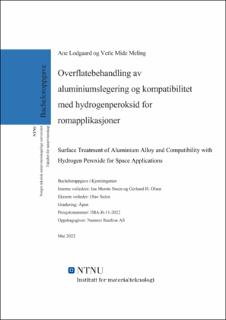| dc.contributor.advisor | Stuen, Ina Merete | |
| dc.contributor.advisor | Olsen, Gerhard Henning | |
| dc.contributor.advisor | Sulen, Olav | |
| dc.contributor.author | Lodgaard, Ane | |
| dc.contributor.author | Meling, Vetle Mide | |
| dc.date.accessioned | 2022-07-06T17:20:40Z | |
| dc.date.available | 2022-07-06T17:20:40Z | |
| dc.date.issued | 2022 | |
| dc.identifier | no.ntnu:inspera:113593029:113594774 | |
| dc.identifier.uri | https://hdl.handle.net/11250/3003264 | |
| dc.description.abstract | Nammo har fått en kontrakt som innebærer utvikling av styresystemet Roll and Attitude Control System (RACS) for bæreraketten VEGA-E til European Space Agency (ESA). Styresystemets drivstoffbeholder er av aluminium med legeringen 6082-T6, hvor kravet fra ESA er at hverken beholderen eller drivstoffet skal dekomponeres vesentlig det første året. Hensikten med denne bacheloroppgaven er å muliggjøre endring fra dagens drivstoffløsning hydrazin, til bruk av en mer miljøvennlig løsning – hydrogenperoksid. Denne bacheloroppgaven er med på å bidra til å svare på følgende problemstilling: Hvilken overflatebehandling gjør aluminium med legering 6082-T6 mest mulig kompatibel med hydrogenperoksid for romapplikasjoner? For å besvare denne problemstillingen var det også et sentralt tema å se på hvordan klassifisere kvaliteten av et passiviseringssjikt.
Anodisering med svovelsyre, kjemisk passivisering med salpetersyre og sitronsyre, var passiviseringsmetodene utført på aluminium med legering 6082-T6 i laboratoriet. Disse metodene ble optimalisert ved endring av parameterne som konsentrasjon, tid og spenning. For å måle kompatibiliteten ble prøvene lagt i en løsning med hydrogenperoksid (30%). Instrumenter som Scanning Electron Microscope (SEM), Cross-hatch Cutter og Vickers hardhetstest er benyttet for å analysere sjiktets overflate og egenskaper.
Kjemisk passivisering med salpetersyre (33%) i 24 timer og anodisering med svovelsyre (1 M) med spenning 21,4 V i 2 timer, var to metoder som ga gode indikasjoner til et godt sjikt, ut ifra forsøkene som ble utført. For begge metodene ble pickling med natriumhydroksid (0,5%) i 20 minutter anvendt. Ut ifra ikke destruktiv testene (NDT) og destruktiv testene (DT) ser Cross-hatch Cutter ut som den best egnet testen for å kvalifisere kvaliteten av sjiktet. Disse metodene anbefales for Nammo som et utgangspunkt for videre arbeid med å utvikle endelig passiviseringsmetode for RACS. | |
| dc.description.abstract | Nammo has been awarded a contract involving the development of the Roll and Attitude Control System (RACS) for the VEGA-E launch vehicle to the European Space Agency (ESA). The control system's fuel tank is made of aluminum with the alloy 6082-T6, where the requirement from ESA is that neither the tank nor the fuel must be decomposed significantly in the first year. The purpose of this bachelor's thesis is to enable change from the current fuel solution hydrazine, to the use of a more environmentally friendly solution - hydrogen peroxide. This bachelor's thesis helps to answer the following question: Which surface treatment makes aluminum with alloy 6082-T6 as compatible as possible with hydrogen peroxide for space applications? To answer this question, it was also a key topic to look at how to classify the quality of a passivation layer.
The passivation methods were performed on aluminum with alloy 6082-T6 in the laboratory was Anodizing with sulfuric acid, and chemical passivation with nitric acid and citric acid. These methods were optimized by changing the parameters such as concentration, time and voltage. To measure compatibility, the samples were placed in a solution of hydrogen peroxide (30%). Instruments such as Scanning Electron Microscope (SEM), Cross-hatch Cutter and Vickers hardness test are used to analyze the surface and properties of the layer.
Chemical passivation with nitric acid (33%) for 24 hours and anodization with sulfuric acid (1 M) with a voltage of 21.4 V for 2 hours were two methods that gave good indications of a good layer, based on the experiments that were performed. For both methods, pickling with sodium hydroxide (0.5%) for 20 minutes was used. Based on the non-destructive test (NDT) and destructive tests (DT), the Cross-hatch Cutter looks like the most suitable test to qualify the quality of the layer. These methods are recommended for Nammo as a starting point for further work on developing a final passivation method for RACS. | |
| dc.language | nob | |
| dc.publisher | NTNU | |
| dc.title | Overflatebehandling av aluminiumslegering og kompatibilitet med hydrogenperoksid for romapplikasjoner | |
| dc.type | Bachelor thesis | |
